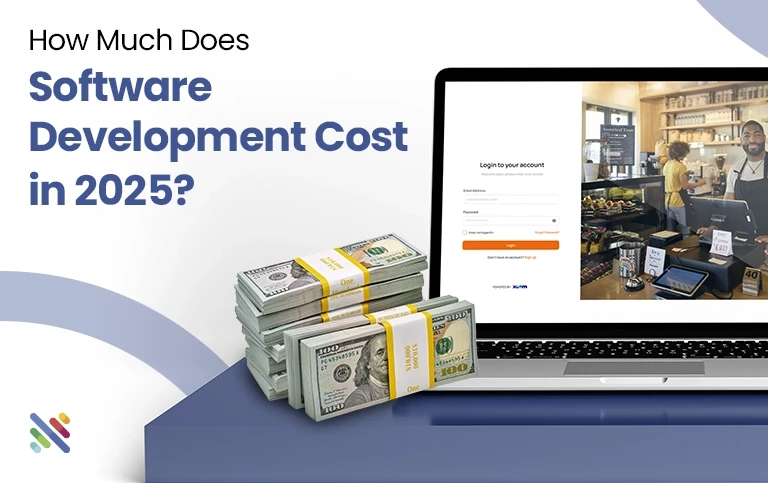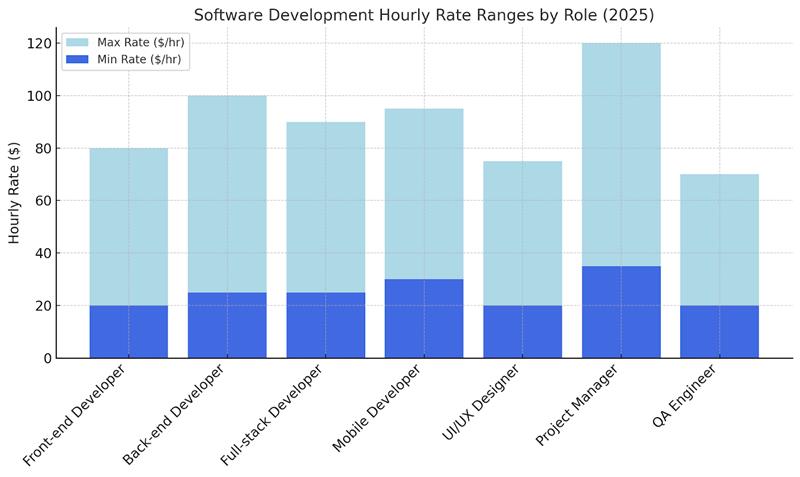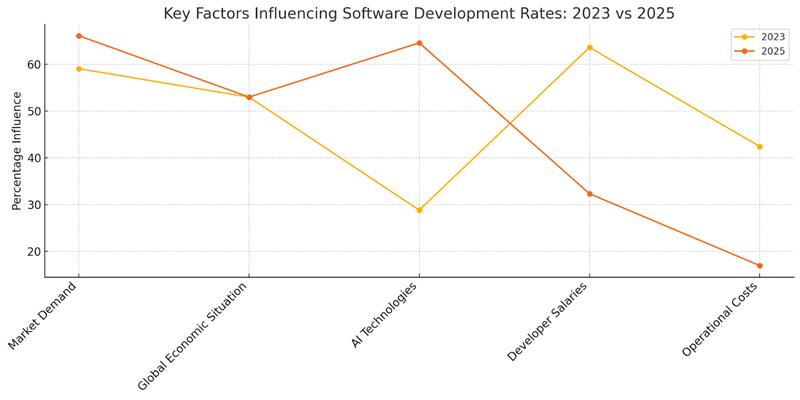
Software Development Costs in 2025: What You Need To Know & Price Comparison
The year 2025 marks a period in which the software development landscape continues to evolve rapidly. As a result, there is a varying pricing model with respect to regional trends and rate fluctuations when businesses or companies search for development partners. Whether a startup is working on an MVP or an enterprise optimizing its digital infrastructure, everyone must have a take on the current software development costs in order to make an informed investment.
In this blog post, we provide an overview of the latest Software Development Rates 2025, explore software development cost trends, and offer software development price comparisons across regions, company sizes, and service categories. An annual look at these changes for the years 2023 to 2025 will give you the insights needed to make predictions for your project budgets.
Overview of Companies That Took Part in the Survey
One must understand who shapes the current scene of software development prices. To shine some light on this issue, a recent global survey categorizes software development companies by size and location to gain significant insight into their business make-up and market strategy.
Company Size Breakdown
This breakdown appears in the survey listing small, medium-sized, or large companies, but the pool of respondents mostly comprises small to medium-sized enterprises:
- 58% of the respondents are companies with less than 100 employees, qualifying them as small to medium-sized enterprises (SMEs). These companies typically offer affordable and more flexible services to startups and businesses seeking budget-friendly development options.
- 29.23% of firms with 100 to 999 employees signify mid-sized firms that usually have more defined processes, larger technical manpower, and structured lending workflows.
- 1.54% of the surveyed companies have more than 1,000 employees, representing a small group of enterprise-level software firms with capabilities in managing complex and large-scale projects across various global markets.
This composition demonstrates that the software outsourcing process remains a significant undertaking for SMEs, aligning with the growing market demand for agile and cost-effective development models.
Company Location Breakdown
When we consider the reasons for geographical locations, cost-effective service delivery and the availability of skilled human resources are what really matter in the choice. Here’s how the locations fare:
- India comes first, with 26.15% of companies operating from there. India's supremacy can be attributed to its vast pool of engineering talent and attractive pricing models. According to a report by Deloitte, India remains one of the top outsourcing destinations globally, offering quality services at competitive rates.
- Europe and the United States follow up with 13.86% and 13.85%, respectively. European countries such as Ireland, Serbia, the Netherlands, Italy, Romania, Portugal, North Macedonia, Cyprus, and Armenia are quickly becoming outsourcing hubs due to their well-developed education systems and multilingual talent.
- That constitutes around 18.46%, affirming Eastern Europe as a prime destination for tech outsourcing, notwithstanding recent geopolitical turbulence.
- The remaining Asian countries, apart from India, account for approximately 6.16%, with the UAE, Bangladesh, Hong Kong, and Malaysia fast gaining prominence.
- Canada and the UK each have a classification of 6.15%, rendering high-end services primarily to Western markets.
- Pakistan, Vietnam, Brazil, Australia, and others account for an additional 9.24%, contributing to international diversification in outsourcing services.
Target Regions for Software Development Services
Another layer of insight concerns the target markets that these outsourcing firms pay particular attention to. This is helpful in understanding where demand is growing and where providers are channeling their resources.
Key Target Markets & Regional Shifts (2023 vs 2025)
Region | 2025 (%) | 2023 (%) | Change |
North America | 76.92% | 86.4% | ▼ 9.48 pp |
Europe | 73.2% | 72.7% | ▲ 0.5 pp |
Middle East | 38.46% | 31.8% | ▲ 6.66 pp |
Australia & New Zealand | 30.77% | 28.8% | ▲ 1.97 pp |
Latin America | 20% | 13.6% | ▲ 6.4 pp |
Southeast Asia | 16.9% | 21.2% | ▼ 4.3 pp |
South Asia | 15.5% | 6.1% | ▲ 9.4 pp |
East Asia | 9.23% | 9.1% | ▲ 0.13 pp |
Africa | 6.15% | 12.1% | ▼ 5.95 pp |
Key Observations & Trends
The following insights analyze shifting regional priorities among software development firms:
- North America remains at the top, but with a 9.48-point drop, diversification in the outsourcing focus is on the table.
- Europe shows a steady interest with some improvement, cementing its place as a strategic market.
- The Middle East and Latin America exhibit notable spikes in interest, indicating increased demand resulting from digital transformation in these emerging economies.
- South Asia’s spurt (+9.4 points) indicates an increasing awareness of its developmental potential and infrastructure enhancements.
- In contrast, Africa and Southeast Asia experienced a decline, possibly due to market instability or shifting geopolitical risk.
These shifts indicate a rebalancing at the global level, as companies struggle to balance cost, access to talent, and regional stability.
Software Development Price Ranges in 2025
Pricing remains one of the most decisive factors in selecting a software development partner. Here is a breakdown of current hourly rates worldwide:
Current Hourly Rate Distribution (2025)
Price Range | Percentage (%) |
< $20/hr | 10.77% |
$20–$29/hr | 29.23% |
$30–$49/hr | 27.69% |
$50–$99/hr | 26.15% |
$100–$149/hr | 4.62% |
$150–$199/hr | 1.54% |
- 83.08% of all surveyed companies set their hourly charge between $20 and $99, which indicates that this pricing tier is definitely the most competitive.
- The most common ranges are for $20-29, which are suitable for small- to medium-sized outsourcing companies, where a good mixture of cost-efficiency and skill is available.
- Only 6.16 percent of companies charge more than $100 per hour, most of which are enterprise-grade companies that provide high-end solutions.
Price Rate Comparison: 2025 vs 2023
Let’s examine how software development rates have evolved over the past year:
Hourly Rate | 2025 | 2023 | Change |
< $20/hr | 10.77% | 7.58% | ▲ 3.19 pp |
$20–$29/hr | 29.23% | 21.21% | ▲ 8.02 pp |
$30–$49/hr | 27.69% | 36.49% | ▼ 8.8 pp |
$50–$99/hr | 26.15% | 30.3% | ▼ 4.15 pp |
$100–$149/hr | 4.62% | 3.03% | ▲ 1.59 pp |
$150–$199/hr | 1.54% | 1.52% | ≈ |
Key Takeaways
- There has been a remarkable shift for the $20-$29/hr range, which experienced the highest growth in 2025. This suggests that there is a growing demand for affordable development services among startups and small to medium-sized businesses (SMBs) alike.
- The $30-$49/hr segment has decreased from $38-$39/hr, but a significant market share remains evident. There is still demand for mid-tier expertise, but the companies are looking for lower-priced alternatives.
- The marginal rise above $100/hr with regard to high-end pricing indicated continued but selective demand for enterprise-grade, complex, or niche solutions.
Detailed Price Range for Software Development Roles in 2025
The charts show the typical hourly rates for various software development roles in 2025, offering publicly available rates from low to high:
Role | Min Rate ($/hr) | Max Rate ($/hr) |
Front-end Developer | $20 | $80 |
Back-end Developer | $25 | $100 |
Full-stack Developer | $25 | $90 |
Mobile Developer | $30 | $95 |
UI/UX Designer | $20 | $75 |
Project Manager | $35 | $120 |
QA Engineer | $20 | $70 |
These rates vary considerably from one region to another, depending on the years of experience and complexity of projects. For example, developers may be offered the high end of the spectrum in regions like North America or Western Europe, while cheaper rates would be available in South Asia.
Have Companies Changed Their Rates in 2025?
As per the recent survey information:
- 58.5 independent respondents reported no change in their rates, indicating stability.
- A 27.7% increase would suggest a slight increase, presumably caused by inflation or the accumulation of experience.
- 9.2 would suggest some decrease, presumably caused by increased competition or automation.
- 4.6 only claims to have increased rates by leaps and bounds.
Key Takeaways
- Market stays largely stable, with more than half maintaining pricing.
- On the other hand, small margins seem to be king, as no major pricing soldier comes out of its combat first.
- Dismal inflation of some countries (e.g., USA or UK) and continuous upswing of the project demands only helped in the subtle modulation of rates instead of inclining abrupt augmentations.
2025 vs 2023 Rate Change Comparison
Rate Change Type | 2025 (%) | 2023 (%) |
No Change | 58.5 | 63.6 |
Slight Increase | 27.7 | 24.2 |
Slight Decrease | 9.2 | 4.6 |
Significant Increase | 4.6 | 7.6 |
Significant Decrease | 0 | 0 |
Key Observations
- Fewer companies adjusted their prices significantly in 2025.
- Slightly more companies reported decreasing their rates this year, at 9.2%, than did so in 4.6% the previous year, mainly from pressure to compete in areas like Eastern Europe and South Asia.
What Do Companies Think About Market Rates?
Within this framework, they were asked about their assessment of the market:
- 35.4% saw a slight rise in rates.
- 29.2% felt the rates remained stable.
- 20.0% saw a slight decline.
- 13.8% saw a significant increase.
- Only 1.5% saw a severe decrease.
This data suggests that more than half (55.4%) feel there is a mild stir in the market, indicating moderate volatility.
Perception vs Reality: Misalignment in Market Understanding
Change Type | Perception (%) | Reality (%) |
Stable Rates | 29.2 | 58.5 |
Slight Increase | 35.4 | 27.7 |
Significant Increase | 13.8 | 4.6 |
Slight Decrease | 20.0 | 9.2 |
Significant Decrease | 1.5 | 0 |
Insights
- Companies often overestimate volatility, particularly in the context of price rises.
- The real market is much more stable than it is perceived to be.
- This misalignment may arise due to increased competition, changing tech demands, or regional media influencing pricing sentiment.
How to Compare Software Development Rates Efficiently?
When analyzing the Software Development Pricing Comparison for your project:
- Region-Based Evaluation: Because of geography, rates differ dramatically. India or Bangladesh may charge $20/hr for a service, while that amount in the U.S. may fetch $120/hr.
- Consider Expertise: Low rates don't equal value. Consider past projects, technology stack, and complexity profiles.
- Project Scope: Fixed-price versus hourly action is bound to affect the ultimate cost. Choose according to how well-defined your project scope is.
- Hidden Costs: Project management, QA, DevOps, and support—including most of those costs—are recommended to be excluded, as these costs are usually accounted for differently.
- Agility and scalability: A cheaper partner may prove to be much costlier in the long run due to a lack of agility or scalability.
Solid-State Pricing Trends in Software Development for 2025
Stabilization in Pricing
The market has matured with a more mature style, with 58.5% of the firms indicating no changes at all in their rates as opposed to 63.6% in 2023. Excellent signs to buyers and vendors alike, the cost structure is stabilized and predictable.
Inflation-Caused Rise in Costs
Almost 28% of firms have increased their prices, an increase caused by the increase in labor costs, inflation, and the customer's demand for more advanced capabilities such as AI, blockchain, and cybersecurity.
Declining Rates in Certain Segments
Interestingly, 9.2% of such companies reduced rates because more automation and competition were being introduced, coupled with off-the-shelf low-code/no-code platforms, which are significantly reducing the demand for custom development.
Target Regions Diversification.
Focus on North America decreased from 86.4% in 2023 to 76.92% in 2025, while the Middle East gained by 6.6% and Latin America by 6.4%, which indicates diversity in outsourcing needs.
Why Have Software Development Rates Changed?
These pricing trends are being produced by a number of factors that include:
- AI & Automation: With GitHub Copilot and AI-augmented code generation making it possible to turn around work quicker, developers can keep prices steady or even reduce them.
- Global Competition: Emerging new players in the competitive marketplace from Africa, LATAM, and South Asia.
- Hybrid Models: With remote and hybrid working structures, all of a sudden, overhead costs reduce, allowing small-sized firms to price affordably.
- Market Oversaturation: This is one of those things that are institutional in which a circulation of many companies offering the development price deflation in such commoditized services like mobile app development or building websites.
Key Factors Influencing the Market: 2023–2025 Comparison
Shifting Dynamics in Cost Drivers
The development of software incurs several costs that depend on various factors, including macroeconomic conditions affecting global economies and the internal operations of businesses themselves. The comparison between 2023 and 2025 reveals that what truly drives price changes in the industry today is significantly different.
Factor | 2023 (%) | 2025 (%) |
Market Demand | 59.09 | 66.15 |
Global Economic Situation | 53.00 | 53.00 |
AI Technologies | 28.79 | 64.62 |
Developer Salaries | 63.64 | 32.31 |
Operational Costs | 42.42 | 16.92 |
Key Observations
- The Growing Influence of AI: The effect of AI technologies more than doubled (from 28.79% in 2023 to 64.62% in 2025), highlighting its role in boosting automation, reducing human workloads, and optimizing the development pipeline.
- Market Demand Remains Key: It maintains its lead as before (66.15% in 2025) in direct dependence on a supply-demand gap to determine price.
- Lower Focus on Developer in Salaries & Operational Costs: The drastic fall in that internal factor signifies a maturing labor market and improved operational efficiency in companies.
Strategies to Remain Competitive Amid Rate Changes
The changing landscape is injecting innovation into cautious pricing strategies, and thus, firms mostly focus on tools and processes rather than being reactive to deficit pay cuts.
Actions Taken by Companies
Strategy | % of Companies |
Adopted AI tools and technologies | 69.23% |
Improved internal processes | 66.15% |
Invested in development tools | 47.69% |
Reduced operational costs | 27.69% |
Added more services at the same rate | 18.46% |
Reduced rates | 16.92% |
Hired more developers | 10.00% |
Used unique strategies | 4.62% |
Key Takeaways
AI Adoption Is the Number 1 Strategy: Nearly 7 out of 10 companies are utilizing AI as a means to enhance productivity, automation, and code quality.
Focus on Value, not Price: Rate reduction was practiced by only 17%, indicating that businesses prefer to add value through tools and services rather than cutting prices.
Customer Relationships vs Rate Changes
Most companies were able to maintain their client relationships, notwithstanding minor price adjustments.
Effects of Rate Changes
Impact | % of Companies |
No impact | 50.8% |
Improved client relationships | 23.1% |
Clients expressed concern | 10.8% |
Lost clients due to rate changes | 7.7% |
Gained clients due to competitive pricing | 6.2% |
Trend Summary
- Seventy-five percent (75.3%) of companies reported either unaffected or improved relationships in this case. This means that trust, service quality, and expertise matter much more than a slight change in rates for clients.
- Only 13.9% of the market experienced churn due to pricing, indicating that the market values consistency and value delivery.
Summary of 2025 Software Development Costs Landscape
- Stability Reigns: 58.5 percent of companies did not change their rates in 2025, continuing a trend that began in 2023.
- AI Dominates: AI had a surged impact on the cost structure, with almost 70 percent of the firms using it to remain competitive.
- Pricing ≠ Client Loyalty: The client relations of over 75 percent of respondents remained constant or improved without regard to rate adjustment.
- Rates Clustered Between $20-$99/hour: More than 80% of companies are within this range, proving that it constitutes the global average range.
- Regions Still Dominating: North America and Europe are the most targeted and competitive among markets.
What Should You Expect from Software Development Costs 2025?
2025 is a year that offers both excellent pricing and a diverse talent pool to anyone interested in creating anything from a small app to large enterprise-grade systems. Between mid-range services priced at $20–$ 99/hr, which dominate the market, businesses have numerous options for developers across various geographic locations, skill sets, and project types.
The software development industry rates exhibit small fluctuations; however, the trendlines that govern these fluctuations indicate some measure of stability. Companies are becoming increasingly focused on value, speed of delivery, and domain knowledge rather than cost.
If you need assistance in choosing the best development partner according to your budget and requirements, contact Netclues to help you with strategic insights, cost analysis, and vendor recommendations that will best serve the interests of your development spend.
Frequently Asked Questions: Software Development Costs in 2025
1. How much does software development cost in 2025?
In 2025, software development costs typically range from $25,000 for an MVP to over $200,000 for a full-featured enterprise app. The total cost depends on complexity, region, and team structure.
2. What are the biggest factors affecting software development costs?
Project complexity, feature scope, development team's location, experience level, engagement model (fixed vs hourly), and compliance needs are the top cost influencers.
3. Where is the cheapest place to outsource software development in 2025?
In 2025, countries such as India, Vietnam, the Philippines, and those in Eastern Europe offer competitive rates and high-quality output across various software project types.
4. Is it better to hire a freelancer or a software development agency?
Freelancers are cost-effective for small tasks or MVPs. Agencies provide scalability, broader expertise, and dedicated project management—ideal for complex or long-term builds.
5. How can I estimate the cost of my software project?
Start by defining your core features, selecting your target platform, and consulting with development professionals for a quote. Accurate scoping reduces surprises and rework.
6. What is the average hourly rate for software developers in 2025?
- Asia: $20–$50/hr
- Eastern Europe: $30–$70/hr
- North America: $80–$150/hr
- Rates depend on skill, location, and tech stack.
7. What’s the best pricing model for software development in 2025?
- Fixed-price: Best for well-defined projects
- Time & Material (T&M): Ideal for agile or flexible scopes
- Dedicated team: Suitable for ongoing product development
8. What hidden costs should I consider in software development?
Common hidden costs include:
- Post-launch maintenance
- Third-party API integration
- Cloud hosting
- Security/compliance (e.g., GDPR, HIPAA)
- QA testing and scaling infrastructure
9. Can I build software on a tight budget without sacrificing quality?
Yes—start with an MVP, use open-source tools or low-code platforms, prioritize core features, and choose cost-effective outsourcing partners with strong portfolios.
10. How do I choose the right development partner for my budget?
Look for teams with:
- Proven experience
- Transparent pricing
- Strong tech stack alignment
- Good communication
- Positive client reviews
- Compare detailed proposals before committing.
Regional Software Development Costs in 2025
11. What are typical software development costs in the USA in 2025?
In the USA, software development costs range between $100 to $200 per hour. Full-featured apps often cost $ 150,000 or more, depending on their scope and platform.
12. How much does it cost to build software in India in 2025?
India remains highly cost-effective in 2025. Hourly rates range from $20 to $45, and full projects typically cost $15,000 to $60,000, based on complexity.
13. What are software development rates in the UK in 2025?
UK rates average between £70 and £120 per hour, depending on expertise, location, and tech stack. Most complete applications start at £25,000+.
14. Is Eastern Europe still affordable for software outsourcing in 2025?
Yes. Eastern Europe offers strong technical talent, mid-range pricing ($30–$65/hr), and reliable English communication—making it a top outsourcing region.








